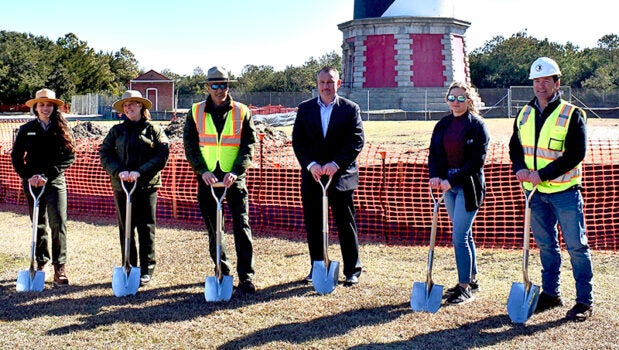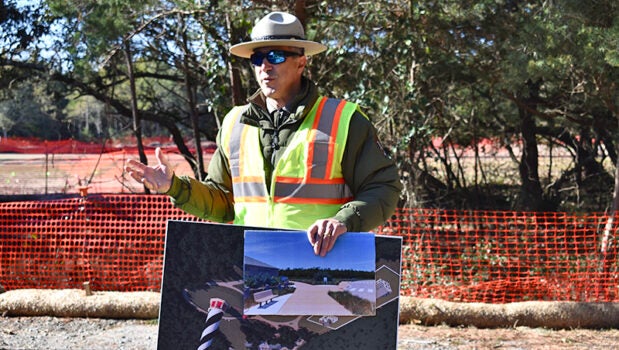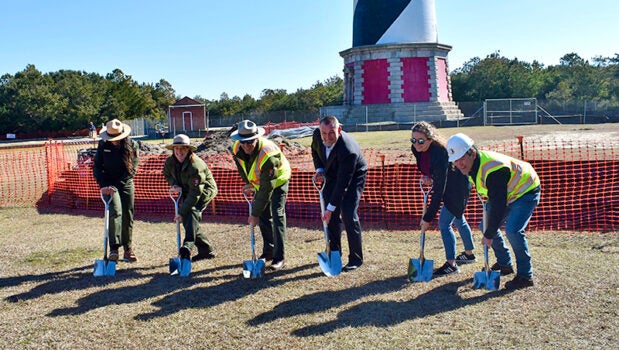$19.2 million Cape Hatteras Lighthouse restoration project begins
Published 3:39 pm Thursday, February 22, 2024
|
Getting your Trinity Audio player ready...
|
The Outer Banks has perhaps become most recognizable by its series of iconic structures: lighthouses. Serving as a guide for mariners the past 154 years, the Cape Hatteras Lighthouse has weathered immeasurable amounts storms and withstood the test of time. Due to its location, elemental exposure and highly-trafficked landscape, this national treasure is in need of a major remodel. The National Park Service (NPS) has awarded a $19.2 million contract to Stone & Lime Historic Restoration Services, Inc. to revitalize the structure and enhance its historic charm.
“When this project is done, the lighthouse will be in better shape than it has been since it was built in 1870,” said Cape Hatteras National Seashore Superintendent Dave Hallac. This 18-month project includes a plethora of work for the tallest traditional lighthouse in the United States. From rehabilitating the interior to restoring the exterior, practically every inch of the lighthouse will be worked on. Plans include restoring crucial architectural components to match that of its original design, repairing masonry, removing corrosion, adding a replica of the original (pre-1920) decorative metal octagonal fence with granite base around the structure, and replacing the light beacon with a replica of the original first-order Fresnel lens.
Not only will the lighthouse itself be refreshed, but the landscape surrounding the historical structure will also see enhancements. The oil house is set to be rehabilitated, a new walkway has been designed to better visitor experience and improve circulation, and the Keepers of the Light Amphitheater stones will be relocated to provide interpretation of the lighthouse keeper’s role. Hallac explained, “Guests will be able to understand the history of the lighthouse but also understand that the lighthouse was more than just a structure. There were lighthouse keepers and they were critical part of its operations.”
During renovations, lighthouse climbing will not be possible. About 200-ft. of scaffolding will encircle the structure to enable workers easier access. The site itself, Hallac said, will still be open to the public for visitation, but with limited access to certain areas which will be under construction. Stone & Lime vice president Chris Dabek is hopeful the project will be completed at the end of 2025. The NPS aims to have the lighthouse open for climbing again in the summer of 2026.
“This is really a once in a career opportunity,” shared Ed Milch, general superintendent with Stone & Lime. “It’s pretty humbling to be involved in this project.” Approximately 500,000 people visit the Cape Hatteras Light Station annually. Its popularity has attracted attention from all over the world, which is why the NPS found it imperative to take action in preserving the site and remedying impacts from high traffic volume. “I think a lot of the country sees this particular lighthouse as a beacon of America,” Hallac commented.
Danielle Puleo video
Mariners may wonder what the night sky will look like while this project takes place. NPS explained that there will be several light outages over the next year and a half, specifically between April-May 2024, during the installation of a temporary beacon, and again in June-July 2025, during the installation of the replica Fresnel lens. The temporary beacon will pulsate rather than rotate, and only reach 14 nautical miles rather than the usual 20 nautical miles. However, both lights must be United States Coast Guard (USCG) approved. Dabek relayed that USCG has been involved in the decision-making when it came to light choices. Once the Fresnel lens is installed and begins operating again, the flash pattern may be every 10 seconds instead of 7.5 seconds (the flash pattern was at 10 seconds from at least 1872-1894). The new lens will be much like the original, using the same number of triangular glass prisms and 24 “bull’s eye” lens flashes, to be seen 20 miles away, turning 1/4 rpm. The lens will rotate on a new modern motorized mechanism rather than the original chariot wheel system.
As for the walking path and additional historic structures, Hallac was excited to introduce plans for a colored concrete path with new interpretative panels and educational signage. The path is to be lined with rope and bollards in an effort to stay consistent with the historical look and feel of the area. A new stockade fence will also line both the Principal Keeper’s Quarters and Double Keepers’ Quarters (Museum of the Sea) to match the original landscape of the early historic period (1870-1890s).
To stay up to date on the progress of this project, as well as find out more about site accessibility, visit go.nps.gov/cahalighthouserestoration. Education programs outside the lighthouse will also highlight project updates.
SUBSCRIBE TO THE COASTLAND TIMES TODAY!









